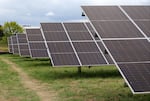Carlos Interian lives with his family on the lower level of an apartment complex in the Cully neighborhood of Northeast Portland. He’s a father of two, a 7-year-old son and a 1-year-old daughter. To help keep his kids entertained, the house cleaned and make meals for the family, Interian said there is always something using electricity.
“We use the internet, the TV, we turn on music for the kids to entertain them,” he said. “To clean, we use the vacuum. We also use the stove, the microwave, the refrigerator. We use a lot of electricity.”

Carlos Interian lives with his two kids and wife in an apartment complex in the Cully neighborhood of Portland, Ore., on Aug. 22, 2024. He signed up to receive solar credits through the PDX Community Solar project. He is estimated to save more than $500 on his energy bills a year.
Monica Samayoa / OPB
As a Pacific Power customer, Interian’s bills have increased by more than 25% over the past two years. Right now, he pays about $80 a month on his energy bills. In the winter, it’s about $100 a month.
If Oregon utility regulators approved a pending rate increase proposal, Interian could see his bills go up by 14% starting in 2025. It’s a pinch many Oregonians are feeling currently. In the past five years, all of Oregon’s major for-profit utilities have increased their energy rates drastically, with some customers paying nearly 50% more than what they did in 2020.
“I don’t make enough to pay the bills,” he said.
Interian works as a mover, but recently injured himself on the job. As a result, he said he is working less.
But Interian and other qualified Cully neighborhood residents could see relief on their energy bills starting in October.
Verde, an environmental justice nonprofit, and Bonneville Environmental Foundation have teamed up to create one of Portland’s first large scale community solar projects aimed at helping lower energy bills between 30% to 45% for about 150 qualified low-income residents in the Cully neighborhood.

PDX Community Solar is a more-than-2,200-panel project, located in Northeast Portland, aimed at helping reduce energy bills for low-income qualified Cully neighborhood residents, Aug. 22, 2024. Once completed, the solar project could power up to 150 homes.
Monica Samayoa / OPB
Interian is hopeful being part of the program will help him save both energy and money.
“It’s good because if you are paying $100 a month, now you could pay between $50 to $60 a month,” he said. “You can save a good amount of money to help pay for other things you need.”
Programs like community solar not only allow people who don’t have their own rooftop solar to benefit from the renewable energy source, but help them access lower energy bills through a credit system. Environmental and climate advocates say it’s a solution that lets renters and lower-income households reap some benefits from the renewable energy transition.
Community solar benefits
PDX Community Solar is a project made up of more than 2,200 solar panels on a three-acre site near the Portland International Airport. It’s connected to Pacific Power’s electricity grid, as they are the main utility servicer for the Northeast quadrant of Portland. The project can generate enough energy to power about 200 homes.
The solar project, which is in its final stages of construction, is set to be the largest community solar project in the city. It’s also the only project in the state that is aimed at filling 60% of its slots with low-income Pacific Power customers.
So far, 60 of the 150 slots have been filled. It is set to begin producing solar power by mid-September, and subscribers could start to receive their first bill credits in October or November.

Once completed, the PDX Community Solar project could power up to 150 homes, Aug. 22, 2024.
Monica Samayoa / OPB
Community solar projects are usually located offsite from where residents live. Qualified residents sign up to receive a monthly solar credit on their energy bills that’s dependent on their annual income.
Power generated from the panels flows to a utility grid, and the utility applies credits to subscribers’ bills without the upfront costs of rooftop solar which can exceed $20,000 to install. Subscribers pay a fee for getting solar, but will receive solar credits more than the cost of the fee if they are below a certain income threshold.
The PDX project is funded through a grant of more than $4 million awarded to Verde from the Portland Clean Energy Fund.
To qualify, people need to live in Northeast Portland, have an income that is 80% or less of the state median income, and be a Pacific Power customer.
Verde Deputy Director Blythe Garma said the organization’s focus is to ensure the credits are going to people of color and low-income residents.
“This project means a lot to us because it means that we’re able to really have the benefits go to our community members,” she said.
Related: Oregon awarded nearly $87 million to increase solar adopting in low-income communities
But outreach wasn’t a breeze.
Garma said people thought the program was too good to be true and were hesitant to sign up. Many people thought it was a scam and didn’t want to fall victim to sharing their personal information.
She said her organization also had to walk through how the subscriptions worked.
“It’s a learning curve,” she said. “I think where Verde is at, we have a lot of trust built in with the community. So, we’ve been able to host workshops with our partners to really help talk through some of those concerns and hesitations.”
Bill relief
After seeing a flier about the community solar power program, Charlee Scott attended one of the workshops. She wondered how a renter like herself could benefit from the program.
Scott, 36, lives in a three-bedroom apartment with her husband and four kids. Usually, there is an extra family member visiting them, she said, so she carefully watches how much she pays a month.
“Over the years, it’s just kind of gone up a little bit,” she said. “But when we had that huge ice storm last year, we saw a big jump in the bill. Typically like winter, it would be maybe anywhere from $70 to $100 or so. And once we had those big ice storms, it was well over $100.”
During the workshop, Scott learned she could save around $300 a year.
“We’re a family of six and being a really resourceful mom, I can do a lot with a little bit of money,” she said.
Related: Utility watchdog calls to cap Oregon rate hikes as energy bills continue to rise
Energy rates from Oregon’s utilities have been on the rise for the past five years. Rates are rising due to the price of natural gas, more renewable energy on the grid and company profits. Yearly double-digit increases from the largest utilities led to a record number of disconnections earlier this year as people struggled to pay their bills. Advocacy groups have called for rate increase caps to limit how much a utility can raise prices per year.
Homes not properly insulated or that have outdated appliances use up more energy, Verde’s Saulo Quezada said, leading to higher costs. He’s seen some energy bills as high as $350 during the winter and about $200 during the summer.
“That’s a lot of money for a family that’s on a fixed income with limited resources,” he said.
Providing a solution like community solar to residents who are facing higher-than-average energy bills is an investment in vulnerable communities, Quezada said.
“If they could save $100, that’s food on the table or maybe that’s keeping the water on or that’s gas money,” he said “What may seem as a small discount is actually a big deal for a lot of our community members.”
‘Taken a village’
Community Solar stemmed from Oregon Senate Bill 1547 in 2016, which required electric utilities to eliminate coal and add more renewable energy to their electricity mix.
Since then, there are currently 25 community solar projects in the state serving more than 4,000 subscribers. An additional 20 community solar projects are expected to come online in 2025.

Verde and Bonneville Environmental Foundation have worked together to create a community solar project that is aimed at helping lower energy bills for 150 Cully neighborhood residents, Aug. 22, 2024.
Monica Samayoa / OPB
“It’s been eight years in the making since the law was passed to where we are now about to turn on the switch here,” said Evan Ramsey, Bonneville Environmental Foundation’s senior director of renewables.
Getting the project running required a lot of help from many different organizations, including the Port of Portland, which owns the parcel of land where the project is located. The port gets the remaining 40% of generated power to help cover ongoing costs of maintaining and operating the solar project.
“It’s really taken a village to achieve what we’re doing here,” Ramsey said, as he hopes the project can be replicated across Oregon to bring bill relief to lower-income residents.
Related: PGE seeks 10.9% rate hike, after record number of disconnections
Funding through the Inflation Reduction Act could make that happen.
Earlier this year, Oregon received nearly $87 million through the federal government’s Solar for All grant. The program is aimed at boosting solar adoption and creating more community solar projects for low-income and rural Oregonians across the state.
For Carlos Interian and his family, being a subscriber to the PDX Community Solar Project will save his household more than $520 a year.
“How wonderful!” he said as he learned for the first time how much his family will save and jokingly asked if he was going to get a huge check mailed to him.
Apart from lowering their energy bills, Interian said being part of the renewable energy transition is important too, as he thinks of what kind of future his daughter will have.

Carlos Interian lives with his two kids and wife in an apartment complex in the Cully neighborhood, Aug. 22, 2024. He signed up to receive solar credits through the PDX Community Solar project. He is estimated to save more than $500 on his energy bills a year.
Monica Samayoa / OPB



